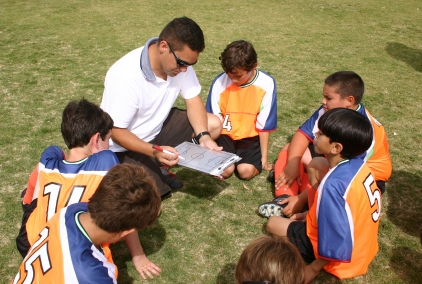 Sam, the youngest and smallest player on our basketball team had been desperate to “bring the ball up” in a game all season. My husband Todd, Sam’s coach, was hesitant because he could see what Sam couldn’t. If Sam dribbled the ball up, he wasn’t likely to make it past half court before it was stolen. This was 10 year-old Sam’s first time playing basketball and truth be told, he hadn’t even mastered dribbling yet.
Sam, the youngest and smallest player on our basketball team had been desperate to “bring the ball up” in a game all season. My husband Todd, Sam’s coach, was hesitant because he could see what Sam couldn’t. If Sam dribbled the ball up, he wasn’t likely to make it past half court before it was stolen. This was 10 year-old Sam’s first time playing basketball and truth be told, he hadn’t even mastered dribbling yet.
But toward the end of the season, in the final minutes of a game, Todd let Sam bring the ball up. At half court Sam was quickly swarmed by players twice his size and lost the ball. When he looked over at Todd tears were welling in his eyes.
A moment later our team got the ball back and a kind soul passed it to Sam, who was then fouled as he attempted a shot. Next Sam was whisked to the free throw line with all eyes on him and the score tied. He nervously prepared for his shot. (They only get one free throw in this league.) Sam eyed the basket and hurled the ball with all his might. We’re still not sure how, but the ball went in. I could almost see the synapses in Sam’s young brain laying down a long-term memory of that moment, which became the high point of Todd’s and my season as well.
Coaching our kids and their buddies was something Todd and I always assumed we would do. Todd’s a teacher. I’m a child psychologist. Between us we’ve done quite a few sports, and have had a wide-range of coaches. I naively thought this combo would make a pretty good coaching partnership.
Here’s how it went. Todd was the head coach and I was an assistant coach of sorts, which often looked more like a good cop and a bad cop. I was usually the one who put kids who misbehaved into short time-outs on the sidelines. And I soon acquired the nugget of wisdom that the quickest way to stop an elementary-aged boy from talking when he should be listening was to have someone else’s Mom (me) sit right next to him.
The honest truth is coaching kids turned out to be much more challenging for Todd and me than either of us expected, for reasons which changed with each new group of kids. In coaching basketball for 4 years at the YMCA, for instance, Todd became the one who always said yes to adding boys who’d never played basketball to his roster. I mean isn’t this what the YMCA is all about, introducing kids to new sports? But because of this we often had “Bad News Bears” teams who rarely won. We noticed that as the boys got older, this was more challenging for them to accept, no matter how much we praised the effort they put in.
We did at least follow the advice of sports psychologists Ronald Smith and Frank Smoll of the University of Washington, in concentrating on player effort. These researchers advise focusing on effort and commitment because those are within the players’ control, unlike the skill-level of the other team. Smith and Smoll also emphasize the importance of a positive relationship between coach and players. I’m reminded of the kids on Todd’s teams who’ve pulled him aside before or after practice to share some non-sports accomplishment with him.
My energetic and upbeat friend Lila has coached her daughters’ first through fourth grade soccer teams for the last 4 years. She also understands the value of getting to know each girl on her team. At the beginning of their work together, Lila talks to each player about her personal hopes and goals for that season.
Although Lila has been successful in many areas as a girls’ soccer coach, she has struggled with her younger daughter’s response to having her mother as coach. Last year Ava, age 7, didn’t appreciate the attention her mother gave to the other players. “You act like you like them more than me!” Eventually Lila talked with Ava about this at home, and they came up with a hand-signal code Ava could use with her mom to let her know when she was upset at practice. Then they agreed on some small overtures Lila could make to Ava at those difficult times.
Lila and Todd are both blessed with deep wells of patience which they draw on regularly as coaches. (I notice this in others because my well tends to be slightly more shallow.) But a coach needs more than simply patience to teach young players a new sport. Smith and Smoll have created DVDs for parents and coaches which describe their coaching strategies supported by many years of research. One of these strategies is that the progression for teaching a skill is:
1. Demonstrate. 2. Explain (briefly). 3. Practice.
These sports psychologists tell coaches that player mistakes should be used as teachable moments. However, when a coach is using a mistake for teaching purposes, s/he should use the “positive sandwich” method. First, note something the player is doing well. Next follow this comment with specific technical instruction. And finally end with a note of encouragement. Praising players when they are giving their maximum effort goes a long way toward increasing effort and commitment during the season.
In one study Smith and Smoll found that girls who played basketball for coaches who’d been trained in these methods had decreased anxiety overall, while girls who played for untrained coaches had increased anxiety as the season progressed.
For many of the above reasons, and because Todd and I have each had coaches who have left negative marks on us, we put a lot of thought into choosing coaches for our kids.
What to Look for in a Coach for Your Child:
- The coach shows good sportsmanship at games and spends consistent time teaching players about sportsmanship.
- The players like and respect the coach and are motivated to work hard when they are around him or her.
- The coach praises kids when they work hard, and doesn’t give empty, undeserved praise.
- The coach is able to understand each child’s current abilities and pushes each appropriately for their level.
- S/he wants the kids to enjoy playing the sport and isn’t focused only on winning.
- In a recreational setting, the coach gives all kids relatively equal playing time at games.
What to Consider If You’ve Decided to Coach Youth Sports:
- Try to find another team parent to be an assistant coach, but make sure his or her coaching style is similar to yours.
- Get to know your players’ parents. Ask them their goals for their child regarding this athletic experience.
- Spend time developing relationships with each player, and ask them their personal goals for the season.
- If your own child is playing on the team, talk to her ahead of time about her concerns about you as coach, and check-in with her regularly throughout the season.
- Read some books on how to coach kids’ sports.
- Come to each practice with many options, so that you can drop a drill that isn’t working. Expect this situation to occur somewhat consistently.
I think I expected the experience of coaching youth sports to be more mild and calm, probably influenced by watching too many After School Special, Hallmark-sponsored TV shows as a child. My vision of the coaching experience was similar to one of those hazy photographs where the bright colors have been tempered.
But what Todd and I found is that when you’re actually working with a team, it’s quite intense. The highs are high and the lows are low (much more like adolescence than middle childhood). The beginning of a new season can feel like strapping yourself into a rollercoaster you’ve never ridden before.
I guess I’ll just chalk coaching up to one of the numerous parenting experiences that did not play out as we expected, but I’m glad we took on just the same.
Please forward this to anyone you know who coaches kids’ sports!
And feel free to leave a comment below on your experience with coaches–

 Sweet Spots: Helping Your Kids Find ENOUGH in Their Lives.
Sweet Spots: Helping Your Kids Find ENOUGH in Their Lives.


I’m so happy to read this. This is the kind of info that needs to be given and not the accidental misinformation that’s at the other blogs. Appreciate your sharing this greatest doc.